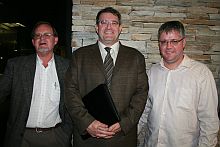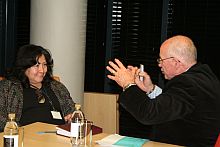SAEON and CSIR launch environmental data platform
|
On June 22, SAEON - in partnership with the CSIR - launched the third phase of its CoGIS (Collaborative Geographical Information Service) project at the Department of Science and Technology (DST) with a demonstration of the data portal’s functions, followed by a cocktail reception.
In his address SAEON Managing Director Johan Pauw said that the event showcased a small step in a much larger process. “Researchers at the SAEON nodes as well as researchers from SAEON’s stakeholder organisations must now start to input new data, access and integrate existing data, analyse and add value to the data, and share knowledge,” he explained.
Platform for multidimensional data
Pauw said that CoGIS would serve as a platform for multidimensional data across time and space, and would enable researchers to interpret and use the data to measure the changing state of the environment and to inform predictive models of global change.
“Through CoGIS, SAEON will be one of the main contributors to the South African Earth Observation Strategy (SAEOS) as well as to the DST’s Global Change Grand Challenge initiative.
Pauw told SAEON stakeholders that the R2,3m that SAEON contributed to the project since its inception in 2005 had been money well spent, particularly as it has had the added benefit of cost savings for the National System of Innovation due to the synergy resulting from the collaboration on the project between SAEON and the CSIR.
Referring to the fact that there is a need to grow a culture of data sharing and data access among global change researchers, he stated that CoGIS is expected to play a significant role in “convincing people to accelerate global change research by providing access to their data”.
He thanked the DST for their financial and moral support, as well Laurie Barwell of CSIR Natural Resources and the Environment for the major role he played in facilitating the collaboration between the CSIR and SAEON.
In his speech, Dr Pat Manders, Executive Director of CSIR Natural Resources and the Environment, thanked the DST for their long-standing support of the CoGIS initiative.
Platform for future collaboration
“Not only is CoGIS a product of collaboration, but it will provide a platform for future collaboration in the global change arena,” Manders said. He explained that innovation is a process, and that it would take time to roll out a multi-faceted product such as CoGIS.
Saying that it was important to have the right people on the right project at the right time, he thanked SAEON’s project manager, Wim Hugo, for his sterling work on the portal.
The speeches were followed by a 30-minute demonstration by Wim Hugo, in which he stressed the following:
- CoGIS is a platform for sharing spatial as well as non-spatial data;
- CoGIS works closely with other data portals that subscribe to the same data and metadata standards;
- The CoGIS system inter-translates between all these metadata standards;
- SAEON uses the data portal for its mandate of preserving knowledge and data for the long term; and
- The portal exposes harvestable data to its partners and makes data available to researchers.
Benefits for CoGIS partners include search facilities tailored to specific requirements, the ability to support numerous spatial operations, the ability to package searches and embed these into other searches, as well as searches according to specific themes. “We want people to use and re-use information from the portal,” Hugo said.
Hugo thanked South African National Parks for contributing test data to the project. He invited everyone present to contribute data and to participate in CoGIS extension programmes. Dr Albert van Jaarsveld, acting President of the NRF, commented that the next challenge would be to get people to use the system and that an extension programme would be required.
In her closing address Marjorie Pyoos, DST Group Executive, assured everyone present that CoGIS would not make any sensitive environmental information available for public consumption.
Pyoos identified the Agricultural Research Council, Council for Geoscience, the South African Risk and Vulnerability Atlas, the South African Earth Observation Strategy and the SA Space Programme as some of the potential partners in the project.
In conclusion she praised SAEON and the CSIR for their sterling work in the development of CoGIS, and said that she looked forward to the next phase of the project.
Related content:
CoGIS - A knowledge geoportal for a knowledge society
The GoGIS Portal














